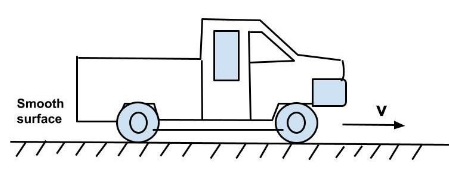
A cart loaded with sand moving with velocity \[V\] sand is falling through the hole as shown in diagram then after falling on the ground sand is:

A. Moving with cart
B. Moving in opposite direction with speed $v$
C. Stationary on the ground
D. Moving with speed ${v_2}$

Answer
483.3k+ views
Hint: We must determine the direction and speed of the sand in order to answer the question. To address this, we'll apply the notion of conservation of momentum, but first, let's get a fundamental understanding of what it means. The law of conservation of momentum asserts that in a closed system, the overall momentum does not change.
Complete step by step answer:
Let us first write all the given values accordingly; the velocity of a sand-filled cart is equal to \[v\]. Now, let us consider the mass of the cart be ${m_1}$ , mass of the sand be ${m_2}$ and velocity of the sand be ${v_2}$.Here we need to find after falling on the ground, the direction and speed of the sand and for that we will apply the law of conservation of momentum principle.
Now, according to the law of conservation of momentum,
\[\left( {{m_1} + {m_2}} \right)v = {m_1} \times v + {m_2} \times {v_2} \\
\Rightarrow {m_1}v + {m_2}v = {m_1}v + {m_2}{v_2} \]
Equating further \[{m_1}v\] will be cancelled out on the both side
${m_2}v = {m_2}{v_2}$
Now, ${m_2}$ will cancelled out so the final value is
$v = {v_2}$
As a result, sand moves in the same direction and at the same speed as the cart.
So, the correct option is A.
Note: Individual bodies are not subject to the law of conservation of momentum, which applies to a system of particles. It's vital to remember that the system's momentum is preserved, not the individual particles'. Individual bodies' momentum can change depending on the situation, but the system's momentum will always be preserved as long as no external net force is exerted on it.
Complete step by step answer:
Let us first write all the given values accordingly; the velocity of a sand-filled cart is equal to \[v\]. Now, let us consider the mass of the cart be ${m_1}$ , mass of the sand be ${m_2}$ and velocity of the sand be ${v_2}$.Here we need to find after falling on the ground, the direction and speed of the sand and for that we will apply the law of conservation of momentum principle.
Now, according to the law of conservation of momentum,
\[\left( {{m_1} + {m_2}} \right)v = {m_1} \times v + {m_2} \times {v_2} \\
\Rightarrow {m_1}v + {m_2}v = {m_1}v + {m_2}{v_2} \]
Equating further \[{m_1}v\] will be cancelled out on the both side
${m_2}v = {m_2}{v_2}$
Now, ${m_2}$ will cancelled out so the final value is
$v = {v_2}$
As a result, sand moves in the same direction and at the same speed as the cart.
So, the correct option is A.
Note: Individual bodies are not subject to the law of conservation of momentum, which applies to a system of particles. It's vital to remember that the system's momentum is preserved, not the individual particles'. Individual bodies' momentum can change depending on the situation, but the system's momentum will always be preserved as long as no external net force is exerted on it.
Recently Updated Pages
Why are manures considered better than fertilizers class 11 biology CBSE

Find the coordinates of the midpoint of the line segment class 11 maths CBSE

Distinguish between static friction limiting friction class 11 physics CBSE

The Chairman of the constituent Assembly was A Jawaharlal class 11 social science CBSE

The first National Commission on Labour NCL submitted class 11 social science CBSE

Number of all subshell of n + l 7 is A 4 B 5 C 6 D class 11 chemistry CBSE

Trending doubts
What is meant by exothermic and endothermic reactions class 11 chemistry CBSE

10 examples of friction in our daily life

One Metric ton is equal to kg A 10000 B 1000 C 100 class 11 physics CBSE

1 Quintal is equal to a 110 kg b 10 kg c 100kg d 1000 class 11 physics CBSE

Difference Between Prokaryotic Cells and Eukaryotic Cells

What are Quantum numbers Explain the quantum number class 11 chemistry CBSE




